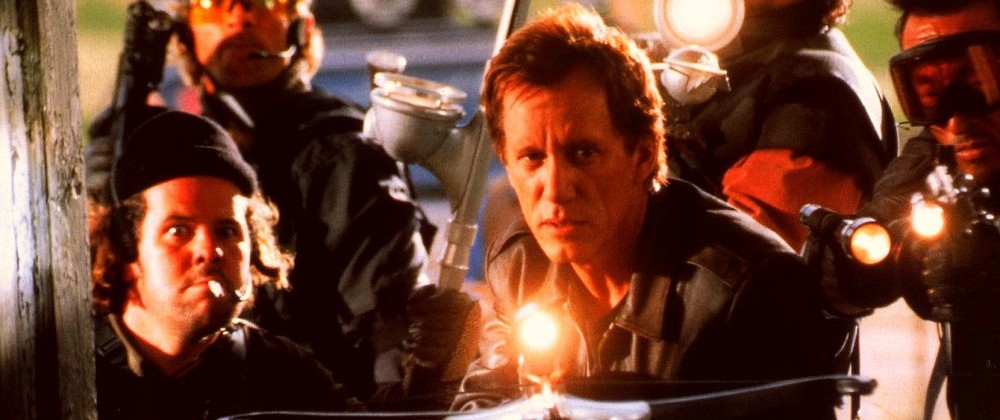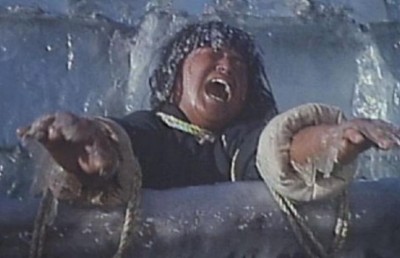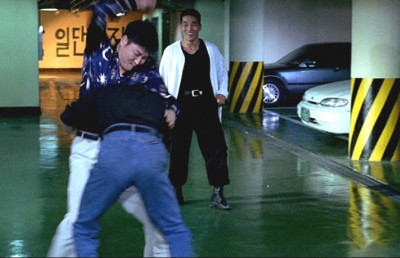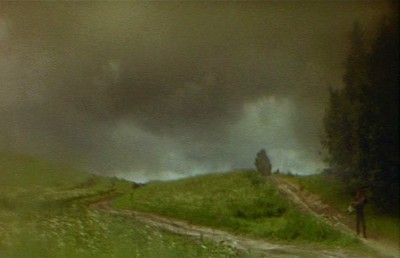Fant-Asia 1998: The Year of the Torture, Part 2
Another high of cinematic excess

Part 2: Japanese Violence and Misogyny in Cultural Context
Most of the torture films were Asian, including five from Japan. To add to the exploitation angle of a torture film sex is often thrown into the mix. This confluence of sex and torture is a staple of the torture film, with the “Ilsa” films being a prime non-Asian example. In most torture films featuring sex and rape women are on the receiving end ( The Black Angel, Evil Dead Trap, The Snare ), though Fant-Asia, being an equal opportunity festival, featured two films with men as victims, the hilarious The Female Inquisitor and the ludicrously unbelievable The Intruder . When sex becomes a tool of the torturer’s trade it recalls the old adage “too much of a good thing can be bad.” Sexual staying power becomes the equivalent of resistance to pain. In The Female Inquisitor old-fashioned torture by pain is supplemented by pleasure overload with the Woody Allenesque “Amplified Simultaneous Orgasm Bed” machine! In The Snare Shintaro Katsu plays Hanzo, a medieval Dirty Harry-style samurai who rids the world of moral sin using any method he sees fit. Hanzo sees himself as a defender of the underprivileged but metes out justice in a style more vile than his sinners. To teach a lesson to a nun who has been running a monastery like a house of ill repute, Hanzo treats her to his “secret weapon.” The nun is cradled hammock style in a fish net and hoisted up and down onto Hanzo’s erect (and apparently very big) penis, hidden just below frame. The pleasure becomes so unbearable that the nun “gives in” to Hanzo, only to crave for more once the torture is over (a variation on the misogynist fantasy myth of the woman falling in love with her rapist).
To put the Fant-Asia torture theme into perspective, there is a long tradition in Hong Kong and Japanese film of women as violent sex-victims: the “Bun Man” films, the first two films in the “Splatter Eros” trilogy, Entrails of a Beautiful Woman , Entrails of a Virgin (the third being The Female Inquisitor ), the “Rapeman” films, the “Hanzo the Blade” series, Teruo Ishii’s “Cruelty” films, the Japanese pink movies, concubine films, the Guinea Pig series, and many Hong Kong Category 3 films). These films come across as being extremely misogynist, especially to a Western audience. On the level of what happens to the women they are, of course, misogynist, but a fairer understanding of these particular films should consider the broader cultural context.
One must begin with the question of violence. The extreme levels of violence found in Hong Kong and Japanese films confounds many Western viewers because Western culture, unlike most Eastern cultures, tends to moralize violence (violence becomes a mirror for evil). For insight into this and other aspects of Japanese popular culture I recommend Ian Buruma’s excellent book, Behind the Mask: on sexual demons, sacred mothers, transvestites, gangsters and other Japanese cultural heroes. Buruma exposes the cultural and mythological roots of Japanese representational forms of violence and misogyny by discussing the Japanese equivalent of Adam and Eve, the brother and sister gods Izanagi and Izanami. In his opening chapter “Mirror of the Gods” Buruma writes:
It is often said that one can get away with almost anything in Japan as long as one is not caught….This is putting it rather simply, but let us compare Izanagi and Izanami with Adam and Eve. The latter were thrown out of the Garden of Eden because Eve took a bite from the apple. They were made conscious of good and evil and only thus was it possible to sin. Japan has no such myth. Izanagi and Izanami were not directly punished for anything they did…. Their crisis came when Izanami was seen by her husband in a state of pollution. The disaster concerned her shame rather than anything she consciously did. Although the gods enjoyed sex with impunity, they were terrified of pollution, especially pollution of death….One could perhaps say that pollution is the Japanese version of original sin. One must add that women in Shinto, as in many religions, are considered to be more polluted than men, because blood is a form of pollution. In some parts of Japan women used to be segregated in special huts during menstruation. …But although sex as such is not a sin in Japanese thought, there does seem to be a strong fear of the destructive forces sexual passion can unleash, especially in women” (p. 4-5).
A few pages later Buruma adds:
Though absolute Evil seems to be absent from Japanese thought, every form of pollution, including wounds, sores, blood, death and even simple uncleanliness is to be feared. The traditional antidote to the polluting forces of nature is purification. …As in many cultures, though few are as extreme, there is a strong belief in Japan that physical suffering and deprivation are purifying experiences” (p. 9, 10).
In the later chapter “Demon Woman” Buruma notes that contemporary images of violence and sexuality are part of a long artistic lineage:
Some of the most extreme examples of aesthetic cruelty are to be found in the so-called decadent art of the late Edo period (mid-nineteenth century), in the woodblock prints of Kuniyoshi…or in the grotesquely violent paintings of Ekin. They shared an artistic fondness for tortured women… Aesthetic cruelty, in Japan as elsewhere, is a way of relieving fear, of exorcising the demons. Because female passion is thought to be more demonic than the weaker, male variety – it is she, after all, who harbours the secret of life – and because of her basic impurity and her capacity to lead men so dangerously astray, it is Woman who has to suffer most (p. 54, 55).
In this lengthy series of quotes we can begin to see the many deep-rooted beliefs that underlie the representation of violence in general and violence toward women in Japanese films. It is the woman who most strongly embodies the power of creation, the potentially destructive powers of sexuality, and the “sin” of pollution. With the belief that physical suffering can lead to purification, we can hypothesize that the torturing of women in these films can be seen as a symbolic cultural exorcism of Japan’s equivalent to original sin (pollution). For example, in Gonin this physical-suffering-as-purification takes on an inward masochistic turn: “It is a psychological truism that suppressed aggression turns inward. Instead of self-assertive heroes, Japan has many masochistic ones: the more heroes suffer, the more heroic they seem. Macho in Japan is often masochism turned into a fine art. In the case of gangsters this is quite literally so: most of them – in films all of them – sport full body tattoos, painfully carved into their skins from the neck to the knees -and sometimes even to the ankles” (Buruma, p. 184). This heroic masochism is also evident in the insane scientists in the wholly over-the-top Japanese science-fiction torture film, Rubber’s Lover. With respect to the violence toward women, while the above does not explain away the misogyny, especially for a Western viewer, it does place it into a proper cultural context, and one for which the word misogyny, like evil, has different reverberations.
One Japanese film featuring torture that was comfortably far removed from conventions of realism was the exceedingly fun The Evil Dead Trap . The film’s central character is Nami, a late night television host who dares her viewers to send her shocking home videos. In the opening scene she views one of these cassettes and is surprised by the graphic images of a woman being brutally murdered. Is it a snuff film, she wonders? Nami and four station employees decide to investigate the warehouse where the tape was filmed. From this point on the film becomes a virtual catalogue of past horror films, with scenes, music, and ideas lifted from such films as: Deep Red, (noose through neck murder), Suspiria (music), Evil Dead (frenetic high speed monster point of view shots), Psycho (a man who murders under the assumed personality of his dead brother), Alien (killer’s dead monster-brother bursts out of his body), and Basket Case (mutant killer brother).
By far the best non-Asian film to feature torture, and one of the festival highlights, was the Austrian serial killer film from 1983, Angst . A murderer is deemed rehabilitated and discharged from an institute for the criminally insane. Right from the opening shots we realize he is anything but rehabilitated. The bulk of the film concerns the killer’s hostage taking of a mother, her disabled son, and her daughter in their middle-class home. The killer haphazardly but effectively incapacitates and then eventually murders each of his victims. Director Gerald Kargl does his utmost to de-glamorize murder by realistically depicting each murder as an ugly, arduous affair. I can not think of another film that so effectively places its audience into the sustained mania of a serial killer’s mind. Erwin Leder’s excellent physical performance as the sadistic killer is internalized by the film’s almost exclusive use of interior monologue. The film’s subjectivity is uniquely etched by Zbigniew Rybczynski’s brilliant use of camera movement and placement that alternately shifts between up-close camera shots that cling to the killer’s body and extreme aerial long shots that assume a God-like vantage. This camera aesthetic has an emotional push/pull effect on the audience, at once forcing us to experience the horrors from up close, and then from a cooler distance. Angst also pays homage to the first great serial killer film, M (Fritz Lang, Germany, 1930). Both killers are loosely based on real life characters (probably Peter Kurten). Like Peter Lorre in M , Leder’s character kills out of an irrepressible physical urge or desire -one that may be sexual, though this is not certain. Like Leder, Lorre is often framed from high above with aerial or extremely high angle camera positions. Another more overt visual reference to M is the ball that rolls around while Leder kills the daughter in the outdoor, covered driveway (recalling the balloon in M‘ s classic opening murder).
Of course not every film at Fant-Asia featured torture – it only felt that way. I’ll conclude my festival report with some random thoughts on other hits and misses, highlights and lowlights at this year’s Fant-Asia. The festival was blessed with the presence of the multi-talented Brian Yuzna, a consummate professional who gave generously of his time and spent as much time socializing as his busy schedule would allow. Yuzna was represented with two films, Progeny and The Dentist 2 (which I unfortunately had to miss). Progeny , which was not a personal project for Yuzna, is an unsuccessful attempt to fuse the edginess of Yuzna’s previous films into a mainstream commercial package. Though there are some effective moments, the film lacks the thematic daring and originality of Yuzna’s previous efforts. The story, part X-Files, part Rosemary’s Baby , tells the story of a young couple whose faith and trust in each other becomes severely tested after they suspect that the woman’s pregnancy is the result of an alien abduction. Weak dialogue and less than impressive visual effects dissipate whatever psychological tension the film builds.
Walk In (Herman Yau, Hong Kong, 1997) begins with a strong opening scene. A woman seems calm and poised as she contemplates throwing herself off the roof of a building. She reassures those around her that she will not die. Just before she jumps we see a cat on the ledge with her. She jumps but a quick close-up reveals her face momentarily transforming into something cat-like. She lands to her apparent death. Moments later however, she miraculously rises from the floor, as good as new, while a few feet away we see a cat lying dead on the floor. The suicide victim has somehow exchanged her life for the cat’s. This soul exchange premise is played for straight thrills and chills in this opening scene, but is then abandoned, to a lesser effect, for a broader, comical tone. A shootout between cops and bank robbers leaves a foolish getaway driver, Tung Nai, in a coma and a police officer, Alex, paralyzed from the waist down. Comic situations prevail when the good looking cop learns of this “walk in” and stages his own suicide to enter into Tung Nai’s less attractive body. For example, after convincing his fiancée that he is Alex inside another body he must make her accept his new less attractive body. He must deal with the personal and financial problems caused by Tung Nai’s mythical cheapness and obstreperous personality. Part of the fun in the similarly themed Face-Off was in watching actors Cage and Travolta act like the other, but this does not occur in Walk-In , where the soul tries instead to adapt to the new body.
A more successful tone shifting film is Beast Cops (Gordon Chan, Dante Lam, 1998), one of the more interesting new Hong Kong films shown at the festival. Mike (Danny Lee) plays a straight-laced detective who teams up with Chao (Anthony Wong) to tackle a yakuza ring. For Mike there is no grey area, just black and white, while the reverse holds true for Chao, a veteran cop who works with his own set of rules. While the yakuza lord Roy is hiding on the lam a younger underling, Pushy-pin, attempts to usurp his leadership. When Roy returns to the group Pushy-pin puts him off guard and then murders him with a vicious knife stab to the neck. Chao, who was close friends with Roy, exacts revenge by single-handedly killing Pushy-pin and most of the yakuza group.
The film introduces us to the tattooed yakuza in an opening shower room scene that sets the film’s gritty realist tone. The yakuza appearing threatening in this opening scene, but gradually lose their edge as the film develops and shifts tone. The realism is underscored in moments of direct camera address where characters tell us why they became cops. One of the film’s most powerful and socially relevant scenes is when Pushy-pin sets a gang of teens on Mike in an effort to end his police meddling. The abrupt attack takes place along a city street at night. The teens first murder an old magazine vendor named “Hope Man,” and nearly do the same to Mike as they chase and beat him with knives, chains, and sticks. Mike manages to escape this manic attack. The sequence ends with the teens walking away gleefully expressing the euphoria and exhilaration they derived from the violence. If one did not know the context, they would think they were coming home from a night at the video arcade! The realism gives way in the end to a surreal hyperrealism. In the film’s climax Chao, playing on Anthony Wong’s crazed screen persona, overcomes death defying odds to single-handedly infiltrate and massacre Pushy-pin and his yakuza group (bullets seem to go right through him!).
The Gingko Bed , a big hit in the Republic of Korea, nearly pulls off a similar hybridity of styles by dipping into a genre pot-pourri of fantasy, horror, comedy, science-fiction, period piece, and love story. The Gingko Bed assumes, as its starting point, the following Buddhist thought: “It has been said that the only miracle Buddhism admits is a change of heart; otherwise we would never be liberated from the past, which is infinite” ( Buddhism: A Way of Life and Thought , Nancy Wilson Ross, 1980, p. 58). The film is set in contemporary Korea and concerns a happily married couple, Su-hyung and Sun-young, who become embattled in a centuries old love triangle. In a former life Su-hyung was a court musician in passionate love with Princess Midan. When the advances of a murderous General Hwang are unrequited by the Princess the General murders Su-hyung. While the reincarnated souls of the two lovers continually re-unite throughout time – even in the form of a Gingko tree that becomes carved into the titular bed – the jealous General Hwang relentlessly chases them through history. As per the passage above, Hwang does not have a change of heart and consequently Su-hyung is unable to liberate himself from the past. The film is entertaining enough but, understandably, is not able to satisfactorily fuse its varied tones and genres. What I found most interesting, and something that may relate to my earlier discussion on the lack of “original sin” in Japanese thought, is that there is no “good” or “evil” in the film. The General does not come across as a villain, but someone with stubborn bad karma!
Fans of Italian horror had far less to cheer about this year, with the number of Italian features down from 10 to 4. Fans were treated to only one new Italian film, Pupi Avati’s The Arcane Enchanter , and retro films Rabid Dogs, Hercules in the Haunted World (both by Mario Bava), and Fulci’s House by the Cemetery. While Italian horror was down there was, unfortunately, an increase in the number of films that were video/disk projected (about ten to twelve, including Rabid Dogs and Hercules ). The Arcane Enchanter , one of the sleepers of the festival, is reminiscent in its gothic atmosphere, non-linear narrative, and methodical pacing, of Avati’s early giallo classic, The House with Windows that Laugh (1976). The film takes place in the mid-18th century and concerns a young seminary student, Giacomo, who is forced to live exile from the church after his implication in an abortion. Giacomo takes on the job of librarian for a mysterious man nicknamed the Arcane Enchanter, a priest who himself was excommunicated for delving into the black arts (a book of incantations entitled “Unmonarchy of the Demon,” a sort of Italian version of the Necronomicon). Much of the film takes place within the dank, candlelit interiors of the monsignor’s castle, which may or may not be haunted by the evil spirit of the monsignor’s previous helper, Riel. The film works through suggestion and draws us into the castle’s sensuous mystery by placing us on the same level of narrative awareness as Giacomo. The film is genuinely creepy, never more so than the scene near the end when Giacomo finds the monsignor in the library standing on a shelf ladder with his back to the camera. The monsignor turns deliberately to face Giacomo/the camera and reveals a monstrous image and then slowly fades away.
Fant-Asia concluded on a bang with the North American premiere of John Carpenter’s Vampires , with Carpenter in presence. After the consecutive financial and critical failures of Escape from L.A. (1996) and Village of the Damned (1995) pressure was on Carpenter to deliver a film that would rekindle the faith and, equally important, prove to the money coffers that he was still a viable property. To those ready to send poor old John to the pastures, put away your pitchforks. Carpenter is back in form. Vampires will not “revolutionize the vampire film,” as Fangoria editor Anthony Timpone claimed in introducing Carpenter to the stage, but it is a solid, entertaining film. Carpenter appeared frail and considerably older than his 50 years, but spoke with a youthful and energetic spark. Vampires , like earlier films Billy the Kid Meets Dracula (1966) and Near Dark (1987), mixes the horror genre with western iconography. James Wood plays Jack Crow, the determined leader of a vampire posse that crusades with the Vatican’s blessing. Crow’s Vatican ordained mission is to stop a powerful 600 year-old vampire, Valek (the tall, gaunt Thomas Ian Griffith in a menacing performance), from obtaining a magical cross (the Berzai Cross) that will make him immune to daylight. In one of many moves that will surely ruffle Catholic feathers, we learn that one of God’s servants, Cardinal Alba (Maximilian Schell), is in communion with Valek.
In the film’s opening scene Crow and his Hawksian posse ambush a vampire lair nesting in a run down home in the middle of the desert. The striking, nearly wordless scene introduces an original vampire killing method. The posse impale the vampires with a crossbow rigged with a rope to a pulley on the back of their truck, and then drag them outdoors where they burst into flames at contact with daylight. Crow and his men manage to kill off every vampire in the lair except for its leader Valek. An irritated Valek repays the favor by ambushing Crow and his partying men at a motel and annihilating all but one of Crow’s posse (only Tony, played by Daniel Baldwin, survives). These two scenes are by far the best moments in the film. Unfortunately they occur within the first 30 minutes and the film never comes close to matching these scenes. Other attacks occur but the novelty of the vampire killing method wears thin after the fourth of fifth time. The pacing is made worse by a less than spectacular climax that appears rushed and in complete contrast to the slowly mounted, suspenseful opening. Having said that, the film will undoubtedly be a crowd pleaser. It is also nice to see Carpenter going back to his roots. The film’s gristled posse would not be out of place in a Sam Peckinpah film (notably The Wild Bunch ) or a Howard Hawks film. While the relationship between the posse and their quarry, the vampires, is reminiscent of that between the zombies and the SWAT team in Dawn of the Dead (1979). Stylistically the film blends Carpenter’s “artless” classicism with more pronounced moments, such as the use of slow motion within action sequences (perhaps a nod again to Peckinpah).
After the film Carpenter fielded questions from the sold out audience. When asked what his immediate plans were he responded, “watching pornography, wrestling, and drinking beer!” This pretty much set the tone of his responses, flippant when the question warranted it – which was often – thoughtful otherwise. For example, when asked why James Wood used such a small handgun Carpenter replied, “Because he has a small dick.” On a more enlightened front, he revealed that he allowed James Wood, a consummate professional, ample room for improvisation. When it was all said and done, Fant-Asia Montreal ’98 was a huge success: 102 screenings with an average attendance of 686. The International prizes went to: 1) Drive , Steve Wang, US, 1996, 2) Airbag , Juanma Bajo Ulloa, Spain, 1997 (which I thought was an awful Spanish Pulp Fiction wannabe that somehow played well to a full audience, but was a dud with a thud when I saw it), 3) PI , Darren Aronofsky, US, 1998. The Asian film prizes went to: 1) Swallowtail Butterfly , Shunji Iwai, Japan, 1996, 2) The Odd One Dies , Patrick Yau, Hong Kong, 1997, 3) Beast Cops , Gordon Chan, Dante Lam, Hong Kong, 1998; and the prize for best short went to Genesis , Nacho Cerda, Spain, 1998.
In the end, kudos must be given to Pierre Corbeil, the Festival director, and the collective work of the Festival programmers, Mitch Davis and Karim Hussain (International Section), Julien Fronfréde (Hong Kong, Japan), Martin Sauvageau (Hong Kong), and André Dubois (Japan). I imagine with each subsequent year their work gets harder. Audience expectation continues to rise, the backlog of available, worthwhile films shrinks, and, in the case of Hong Kong, the number of new potential Fant-Asia material seems to be on the decline. Which can only mean that to survive, Fant-Asia will have to evolve accordingly; not necessarily a bad thing. Let’s just hope that the Fant-Asia brain-(and money)child maintains its collective motivation and will to keep on trucking so that Montreal fans can satiate their yearly fix of the weird, wild and wonderful.













